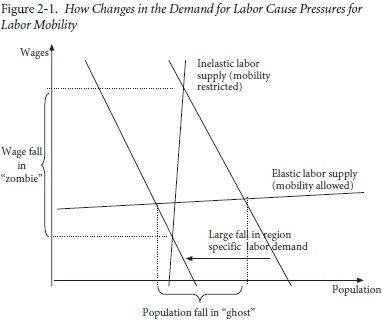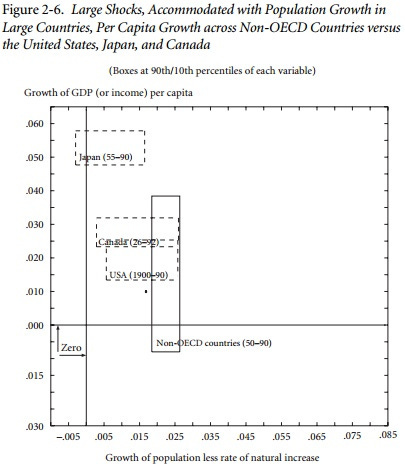Ghost World and Zombieland
I’m embarrassed to admit that I only recently got around to reading Lant Pritchett‘s Let Their People Come: Breaking the Gridlock on Global Labor Mobility. The full text is free and packed with goodness, but I learned the most from Pritchett’s chapter on “ghost” versus “zombie” economies. Key idea:
Large and persistent declines in labor demand in a region, perhaps because of technical changes in agriculture or changes in resources, create two possibilities, which I call “ghosts” or “zombies.” If labor is geographically mobile and hence labor supply is elastic, then large declines in labor demand will lead to large outward migration–the process that created “ghost towns” in the United States.
However, if labor demand falls in a region and labor is trapped in that region, by national boundaries for instance, the labor supply is inelastic and all the accommodation has to come out of falling wages. A region that cannot become a ghost (losing population) becomes a zombie economy–the economy might be dead, but people are forced to live there.
Graphically:
Is this a big deal in the real world? Yes!
There are three sources of evidence, which together suggest that there are typically large shifts in the desired populations of regions. Though it is extremely difficult to separate out which of these are shifts in just an “unconstrained desired” population (due to remediable factors like policies, or, optimistically, institutions) and which are shifts in “optimal” populations, there is some evidence from comparing regions of countries (which share many policies and institutions) that some large fraction of the shifts in desired populations are also shifts in optimal population. These shifts in desired population are accommodated differently depending on the conditions for labor mobility. The three empirical examples are (1) regions of the United States, (2) comparisons of within-country versus cross-country variability of population and output per person growth rates, and (3) population versus output variability in history.
Peek at evidence on (1):
I have assembled five regions of the United States, which, since I created them, I will name: Texaklahoma (Northwest Texas and Oklahoma), Heartland (parts of Iowa, Missouri, Kansas, and Nebraska), Deep South (parts of Arkansas, Mississippi, and Alabama), Pennsylvania Coal and Great Plains North (parts of Kansas and South Dakota). Even with the constraint of contiguity and (mostly) convexity, one can assemble large territories that have seen substantial absolute population decline. The Great Plains North is a territory larger than the United Kingdom, and its population declined 28 percent from 1930 to 1990. Its current population is only a bit more than a third the population it would have been if its population growth had been at the rate of natural increase. The Texaklahoma region is bigger than Bangladesh and is now only 31 percent the population size it would have been in the absence of outmigration.
Peek at evidence on (2):
Peek at evidence on (3):
The nineteenth century was truly an “age of mass migration” (Hatton and Williamson 1998), because many of the “areas of recent settlement” had open borders with respect to immigrants (at least with certain ethnic and national origins). It was also an era of rapid reductions in transport costs and shifts toward freer trade in goods, open capital markets, and massive movements in capital–the first era of globalization. Hence, this period is an interesting example of the question: “How would we expect geographically specific shocks to be accommodated in a globalizing world?” Comparing Ireland to Bolivia highlights the obvious: that nearly all developing countries with negative shocks have seen their populations continue to expand rapidly, while when there was freer labor mobility in the international system, labor movements accommodated negative shocks
Bottom line: If you can believe that huge areas within many countries are optimally empty (or nearly empty), the same could be true for entire countries. Ghost countries, like ghost towns, won’t look pretty. But this is a classic case of “Is a place still ugly if nobody sees it?” Immigration restrictions turn ugliness few people ever see into ugliness millions experience every day.
The post appeared first on Econlib.





A good reason to explore charter cities that are open to massive influxes of capital and labor.
Yeah.